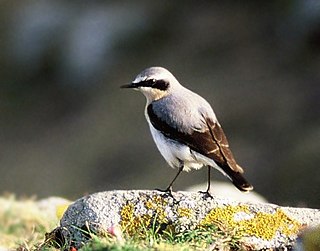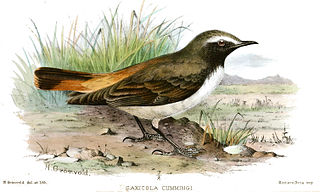
The wheatears are passerine birds of the genus Oenanthe. They were formerly considered to be members of the thrush family, Turdidae, but are now more commonly placed in the flycatcher family, Muscicapidae. This is an Old World group, but the northern wheatear has established a foothold in eastern Canada and Greenland and in western Canada and Alaska.

The isabelline wheatear is a small passerine bird that was formerly classed as a member of the thrush family Turdidae, but is now more generally considered to be an Old World flycatcher in the family Muscicapidae. It is a migratory insectivorous bird. Its habitat is steppe and open countryside and it breeds in southern Russia and Central Asia to northern Pakistan, wintering in Africa and northwestern India. It is a very rare vagrant to western Europe.

The desert wheatear is a wheatear, a small passerine bird that was formerly classed as a member of the thrush family Turdidae, but is now more generally considered to be an Old World flycatcher (Muscicapidae). It is a migratory insectivorous species, 14.5 to 15 cm in length. Both western and eastern forms of the desert wheatear are rare vagrants to western Europe. The western desert wheatear breeds in the Sahara and the northern Arabian peninsula. The eastern race is found in the semi-deserts of Central Asia and in winter in Pakistan and northeast Africa.

The pied wheatear is a wheatear, a small insectivorous passerine bird that was formerly classed as a member of the thrush family Turdidae, but is now more generally considered to be an Old World flycatcher. This migratory central Asiatic wheatear occurs from the extreme southeast of Europe to China, and has been found wintering in India and northeastern Africa. It is a very rare vagrant to western Europe.

The northern wheatear or wheatear is a small passerine bird that was formerly classed as a member of the thrush family Turdidae, but is now more generally considered to be an Old World flycatcher, Muscicapidae. It is the most widespread member of the wheatear genus Oenanthe in Europe and North and Central Asia.

The white-crowned wheatear, or white-crowned black wheatear is a wheatear, a small passerine bird that was formerly classed as a member of the thrush family Turdidae, but is now more generally considered to be an Old World flycatcher, Muscicapidae.

The black wheatear is a wheatear, a small passerine bird that was formerly classed as a member of the thrush family, Turdidae, but is now more generally considered to be an Old World flycatcher of the Muscicapidae.

The masked shrike is a species of bird in the shrike family, Laniidae. It breeds in southeastern Europe and at the eastern end of the Mediterranean, with a separate population in eastern Iraq and western Iran. It is migratory, wintering mainly in northeast Africa. Although it is a short-range migrant, vagrants have occurred widely elsewhere, including northern and western Europe. It is the smallest member of its genus, long-tailed and with a hooked bill. The male has mainly black upperparts, with white on its crown, forehead and supercilium and large white patches on the shoulders and wings. The throat, neck sides and underparts are white, with orange flanks and breast. The female is a duller version of the male, with brownish black upperparts and a grey or buff tone to the shoulders and underparts. The juvenile has grey-brown upperparts with a paler forehead and barring from the head to rump, barred off-white underparts and brown wings аpart from the white primary patches. The species' calls are short and grating, but the song has melodic warbler-like components.

The hooded wheatear is a wheatear, a small insectivorous passerine that was formerly classed as a member of the thrush family Turdidae, but is now more generally considered to be an Old World flycatcher, Muscicapidae.

The mountain wheatear or mountain chat is a small insectivorous passerine bird that is endemic to southwestern Africa.

The capped wheatear is a small insectivorous passerine bird that was formerly classed as a member of the thrush family Turdidae, but is now more generally considered to be an Old World flycatcher, Muscicapidae.

The African firefinch, also called the dark firefinch or blue-billed firefinch due to the color of its bill, is a common species of estrildid finch found in almost all parts of Africa. It has an estimated global extent of occurrence of 5,400,000 km2 (2,100,000 sq mi).

The Karoo chat is a small passerine bird of the Old World flycatcher family Muscicapidae. It is a common resident breeder in southwesternmost Angola, western Namibia and western South Africa. Its habitat is Karoo and desert scrub in the south, extending to the escarpment zone in the north.

The crowned sandgrouse is a species of bird in the sandgrouse family, the Pteroclidae from North Africa and the Middle East.

The Kurdish wheatear, also known as the Kurdistan wheatear, the chestnut-rumped wheatear or the red-rumped wheatear, is a species of bird in the family Muscicapidae. The red-tailed wheatear was formerly considered a subspecies of this bird but is now often regarded as a separate species. The two may intergrade in Iran but it is also possible that the rather differently coloured cummingi is in fact a one-year-old O. xanthoprymna with intermediate plumage.

The red-tailed wheatear, also known as the rusty-tailed wheatear, Persian wheatear or Afghan wheatear, is a small passerine bird breeding in mountainous areas of south-west and central Asia. It belongs to the wheatear genus Oenanthe which was formerly placed in the thrush family Turdidae but is now in the Old World flycatcher family Muscicapidae. The red-tailed wheatear used to be considered a subspecies of the Kurdish wheatear but is now often regarded as a separate species.

Heuglin's wheatear is a small passerine bird in the wheatear genus Oenanthe.

The Atlas wheatear, also known as the black-throated wheatear or Seebohm's wheatear, is a small passerine bird which breeds in the Maghreb region of North Africa and winters in the western Sahel. It was formerly considered a subspecies of the northern wheatear as O. o. seebohmi, but was reclassified as a distinct species by the IOC in 2021.



















